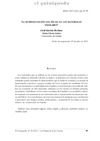Identificador persistente para citar o vincular este elemento:
https://accedacris.ulpgc.es/handle/10553/10228
| Campo DC | Valor | idioma |
|---|---|---|
| dc.contributor.author | Garreta Bochaca, Jordi | en_US |
| dc.contributor.author | Llevot Calvet, Nuria | en_US |
| dc.date.accessioned | 2013-06-13T05:00:17Z | - |
| dc.date.accessioned | 2018-04-25T13:48:31Z | - |
| dc.date.available | 2013-06-13T05:00:17Z | - |
| dc.date.available | 2018-04-25T13:48:31Z | - |
| dc.date.issued | 2011 | en_US |
| dc.identifier.issn | 0213-0610 | en_US |
| dc.identifier.uri | https://accedacris.ulpgc.es/handle/10553/10228 | - |
| dc.description.abstract | Los materiales que se utilizan en los centros educativos, parte del currícula escolar, reflejan la selección cultural, su lógica y la relación con el poder. Sobre estos materiales puede estudiarse la representación que se realiza la sociedad y la escuela de determinados colectivos o grupos sociales, así como su grado de visibilidad. El estudio que presentamos es principalmente empírico, concretamente se ha realizado análisis de contenido de 264 materiales utilizados en los niveles de infantil, primaria, secundaria y bachillerato en los centros escolares de Cataluña. Los resultados obtenidos apuntan a la existencia de un currículum nulo y el predominio de menciones breves del islam y los musulmanes, así como la existencia de imágenes que contribuyen a reproducir una imagen exótica, antimoderna y occidental de los árabes y musulmanes y de su presencia en España. | en_US |
| dc.description.abstract | Materials used in schools as part of student’s curricula, show their cultural, logic and relationship with power. Through these materials it is possible to study the representation that society and schools of certain social groups perform, as much as their level of visibility. The analysis that we present is basically empirical, specifically on the content of 264 materials used by levels of Primary, Secondary and Sixth Form at schools in Cataluña. Results tend to show the existence of virtually nil curricula with predominance of brief mention of Islam and Muslims, as much as the existence of images that contribute to create an exotic atmosphere, anything but modern or westernized of the Arabs and Muslims and their presence in Spain. | en_US |
| dc.format | application/pdf | es |
| dc.language | spa | en_US |
| dc.relation.ispartof | El Guiniguada | en_US |
| dc.source | El Guiniguada. Las Palmas de Gran Canaria: Servicio de Publicaciones, Universidad de Las Palmas de Gran Canaria, 1984 [ISSN 0213-0610], v. 20, 2011, p. 85-97 | en_US |
| dc.subject | 58 Pedagogía | en_US |
| dc.subject.other | Diversidad religiosa | en_US |
| dc.subject.other | Islam | en_US |
| dc.subject.other | Religión y educación | en_US |
| dc.subject.other | Materiales escolares | en_US |
| dc.subject.other | Currículum oculto | en_US |
| dc.title | La representación del Islam en los materiales escolares | en_US |
| dc.type | info:eu-repo/semantics/article | en_US |
| dc.type | Article | en_US |
| dc.compliance.driver | 1 | es |
| dc.identifier.absysnet | 235347 | - |
| dc.identifier.crisid | -;- | - |
| dc.investigacion | Artes y Humanidades | en_US |
| dc.rights.accessrights | info:eu-repo/semantics/openAccess | es |
| dc.type2 | Artículo | en_US |
| dc.identifier.external | -;- | - |
| dc.identifier.ulpgc | Sí | es |
| dc.description.sellofecyt | Sello FECYT | |
| dc.description.esci | ESCI | |
| dc.description.erihplus | ERIH PLUS | |
| item.fulltext | Con texto completo | - |
| item.grantfulltext | open | - |
| Colección: | Guiniguada. 2ª Etapa. n.20, 2011 Artículos | |
Visitas
169
actualizado el 22-feb-2025
Descargas
405
actualizado el 22-feb-2025
Google ScholarTM
Verifica
Comparte
Exporta metadatos
Los elementos en ULPGC accedaCRIS están protegidos por derechos de autor con todos los derechos reservados, a menos que se indique lo contrario.
